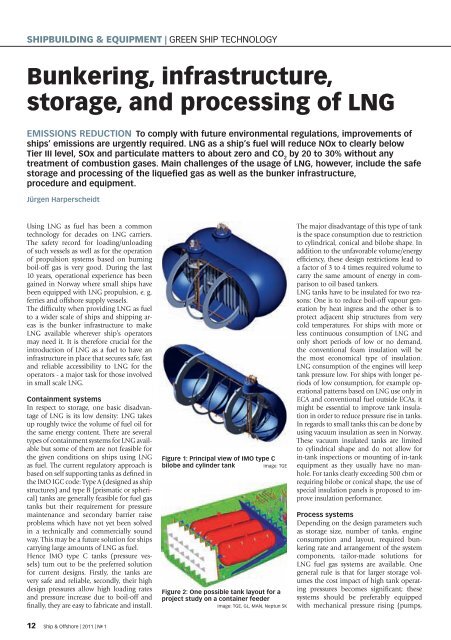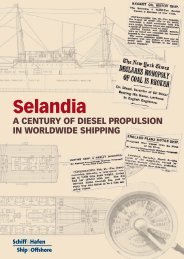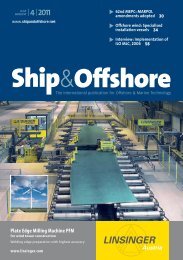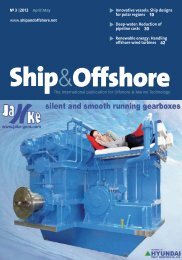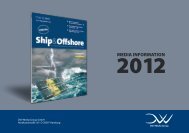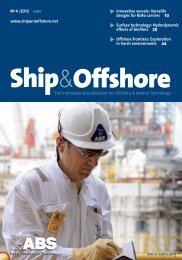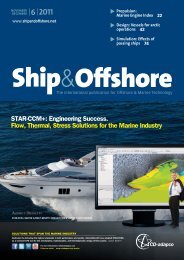Arctic technology: Winterisation of FPSO 38 Cruise ... - Ship & Offshore
Arctic technology: Winterisation of FPSO 38 Cruise ... - Ship & Offshore
Arctic technology: Winterisation of FPSO 38 Cruise ... - Ship & Offshore
Create successful ePaper yourself
Turn your PDF publications into a flip-book with our unique Google optimized e-Paper software.
SHIPBUILDING & EQUIPMENT | GREEN SHIP TECHNOLOGY<br />
Bunkering, infrastructure,<br />
storage, and processing <strong>of</strong> LNG<br />
EMISSIONS REDUCTION To comply with future environmental regulations, improvements <strong>of</strong><br />
ships’ emissions are urgently required. LNG as a ship’s fuel will reduce NOx to clearly below<br />
Tier III level, SOx and particulate matters to about zero and CO 2 by 20 to 30% without any<br />
treatment <strong>of</strong> combustion gases. Main challenges <strong>of</strong> the usage <strong>of</strong> LNG, however, include the safe<br />
storage and processing <strong>of</strong> the liquefi ed gas as well as the bunker infrastructure,<br />
procedure and equipment.<br />
Jürgen Harperscheidt<br />
Using LNG as fuel has been a common<br />
<strong>technology</strong> for decades on LNG carriers.<br />
The safety record for loading/unloading<br />
<strong>of</strong> such vessels as well as for the operation<br />
<strong>of</strong> propulsion systems based on burning<br />
boil-<strong>of</strong>f gas is very good. During the last<br />
10 years, operational experience has been<br />
gained in Norway where small ships have<br />
been equipped with LNG propulsion, e. g.<br />
ferries and <strong>of</strong>fshore supply vessels.<br />
The diffi culty when providing LNG as fuel<br />
to a wider scale <strong>of</strong> ships and shipping areas<br />
is the bunker infrastructure to make<br />
LNG available wherever ship’s operators<br />
may need it. It is therefore crucial for the<br />
introduction <strong>of</strong> LNG as a fuel to have an<br />
infrastructure in place that secures safe, fast<br />
and reliable accessibility to LNG for the<br />
operators - a major task for those involved<br />
in small scale LNG.<br />
Containment systems<br />
In respect to storage, one basic disadvantage<br />
<strong>of</strong> LNG is its low density: LNG takes<br />
up roughly twice the volume <strong>of</strong> fuel oil for<br />
the same energy content. There are several<br />
types <strong>of</strong> containment systems for LNG available<br />
but some <strong>of</strong> them are not feasible for<br />
the given conditions on ships using LNG<br />
as fuel. The current regulatory approach is<br />
based on self supporting tanks as defi ned in<br />
the IMO IGC code: Type A (designed as ship<br />
structures) and type B (prismatic or spherical)<br />
tanks are generally feasible for fuel gas<br />
tanks but their requirement for pressure<br />
maintenance and secondary barrier raise<br />
problems which have not yet been solved<br />
in a technically and commercially sound<br />
way. This may be a future solution for ships<br />
carrying large amounts <strong>of</strong> LNG as fuel.<br />
Hence IMO type C tanks (pressure vessels)<br />
turn out to be the preferred solution<br />
for current designs. Firstly, the tanks are<br />
very safe and reliable, secondly, their high<br />
design pressures allow high loading rates<br />
and pressure increase due to boil-<strong>of</strong>f and<br />
fi nally, they are easy to fabricate and install.<br />
12 <strong>Ship</strong> & <strong>Offshore</strong> | 2011 | N o 1<br />
Figure 1: Principal view <strong>of</strong> IMO type C<br />
bilobe and cylinder tank Image: TGE<br />
Figure 2: One possible tank layout for a<br />
project study on a container feeder<br />
Image: TGE, GL, MAN, Neptun SK<br />
The major disadvantage <strong>of</strong> this type <strong>of</strong> tank<br />
is the space consumption due to restriction<br />
to cylindrical, conical and bilobe shape. In<br />
addition to the unfavorable volume/energy<br />
effi ciency, these design restrictions lead to<br />
a factor <strong>of</strong> 3 to 4 times required volume to<br />
carry the same amount <strong>of</strong> energy in comparison<br />
to oil based tankers.<br />
LNG tanks have to be insulated for two reasons:<br />
One is to reduce boil-<strong>of</strong>f vapour generation<br />
by heat ingress and the other is to<br />
protect adjacent ship structures from very<br />
cold temperatures. For ships with more or<br />
less continuous consumption <strong>of</strong> LNG and<br />
only short periods <strong>of</strong> low or no demand,<br />
the conventional foam insulation will be<br />
the most economical type <strong>of</strong> insulation.<br />
LNG consumption <strong>of</strong> the engines will keep<br />
tank pressure low. For ships with longer periods<br />
<strong>of</strong> low consumption, for example operational<br />
patterns based on LNG use only in<br />
ECA and conventional fuel outside ECAs, it<br />
might be essential to improve tank insulation<br />
in order to reduce pressure rise in tanks.<br />
In regards to small tanks this can be done by<br />
using vacuum insulation as seen in Norway.<br />
These vacuum insulated tanks are limited<br />
to cylindrical shape and do not allow for<br />
in-tank inspections or mounting <strong>of</strong> in-tank<br />
equipment as they usually have no manhole.<br />
For tanks clearly exceeding 500 cbm or<br />
requiring bilobe or conical shape, the use <strong>of</strong><br />
special insulation panels is proposed to improve<br />
insulation performance.<br />
Process systems<br />
Depending on the design parameters such<br />
as storage size, number <strong>of</strong> tanks, engine<br />
consumption and layout, required bunkering<br />
rate and arrangement <strong>of</strong> the system<br />
components, tailor-made solutions for<br />
LNG fuel gas systems are available. One<br />
general rule is that for larger storage volumes<br />
the cost impact <strong>of</strong> high tank operating<br />
pressures becomes signifi cant; these<br />
systems should be preferably equipped<br />
with mechanical pressure rising (pumps,


